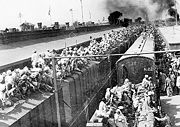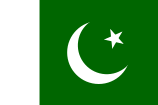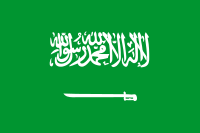Muhajir (Pakistan)
- See Muhajir page for all Muhajir groups in the world
| Muhajirs |
|---|
| Total population |
|
12.2 million[1] |
| Regions with significant populations |
| Pakistan, Bangladesh, United Kingdom, Saudi Arabia, Australia, United Arab Emirates, United States, Canada |
| Languages |
| Urdu |
| Religion |
| Islam (a Sunni majority and a Shia minority) |
| Related ethnic groups |
| Turkic peoples, Tamil, Other Indo-Aryan peoples Memons, Gujaratis, Bengali, Persians, Arabs, Pashtuns |
Muhajir(Urdu: مہاجر) is a diverse term used to describe the Muslim refugees who migrated to Pakistan after the independence in 1947. Traditionally meaning the Muslim refugees who migrated from regions other than the Punjab state of India at the time of Pakistan's independence, in recent years, the term has come to include refugees who've arrived from Burma, Bangladesh, Afghanistan, Iran, Somalia and Iran but for all intents, when the term Muhajir is used, it generally refers to the Muslim refugees from British India.
The term Muhajir itself is now gradually being replaced by the more politically acceptable term "Urdu Speaker" or "Urdu" because of its connotations. Even though 'Urdu speaking' term is still not the correct term to identify a group of people since many of these people claim Middle Eastern, Turkish, Afghan and Indian decent. Many can trace their family roots to the Middle East and Central Asia prior to migration to North and Central South Asia. Many of these claims cannot be verified. The one uniting factor for the people regardless of their origin/race is that their mother tongue is Urdu.
Contents |
Etymology
Muhajir or Mohajir (Arabic: مهاجر) is an Arabic word meaning refugee or immigrant or emigrant. The Islamic calendar Hejira starts when Muhammad and his companions left Mecca for Medina in what is known as Hijra. They were called Muhajirun. The Arabic root word for immigration and emigration is Hijrat.
In Pakistan

The majority of people who migrated after the independence were settled in the port city of Karachi in southern Sindh and in the cities of Hyderabad, Sukkur, Nawabshah and Mirpurkhas.
As well the above many Urdu-speakers settled in the cities of Punjab mainly in Lahore, Multan, Bahawalpur and Rawalpindi
Today, in Pakistan, 7.6% of the population, or around 12 million citizens identify themselves as 'Urdu-Speaking'. Of this number around 8 Million reside in Sindh and around 4 million reside in Punjab and Islamabad.
Culture
Muhajirs are inheritors of the Muslim cultural heritage of South Asia.
Political ideology
Muhajirs hold political opinions ranging from conservative to liberal. Most tend to be secular and support ideals of Western democracy. Muhajirs held comfortable vocations in British India.
Intermarriages
Since the independence in 1947, there have been many intermarriages that took place between Punjabi, Kahmiri, Paskhtuns, Bengali and Persian/Urdu speaking communities, which is the reason that its hard to identify native Urdu-speaking communities in Pakistan, except for the province of Sindh, where many Urdu speaking people still maintain their distinct identity and heritage. However, with the passage of time, local traditions and essences have greatly seeped in, which is why many Urdu speakers in Punjab are so much merged with the Punjabi community that they do not identify them as Urdu speaking at all.
Language
The original language of the Mughals had been Turkish, but after their arrival in South Asia, they came to adopt Persian and later Urdu. The word Urdu is believed to be derived from the Turkish, word 'Ordu', which means army. It was initially called Zaban-e-Ordu or language of the army and later just Urdu. The word 'Ordu' was later anglicised as 'Horde'. Urdu, though of South Asian origin, came to be heavily influenced by Persian and Arabic. Urdu speakers have been speaking this language as their Mother tongue for several centuries. Urdu has been the medium of the literature, history and journalism of South Asian Muslims during the last 200 years. Most of the work was complemented by ancestors of native Urdu speakers in South Asia. Persian language which was the official language during the Mughals was then slowly starting to lose ground to Urdu during the reign of Shah Jahan. It was after the devastating invasion by Nadir Shah of Persia in 1738 that gave death blow to Mughal empire in South Asia, that the Mughals adopted Urdu instead of Persian as the official language of the empire. Then Urdu with official patronage developed high literature
Lifestyle
After the independence when the Muslims migrated to Pakistan they brought different values with them that varied from region to region they migrated from. The urban lifestyle was mostly coloured by the people who migrated to Pakistan after the independence in the major cities of Pakistan, especially Karachi, as they originally immigrated from mostly urban centres of India before the independence of Pakistan. Some of these urban centres, such as Lucknow and Delhi had been seats of culture, learning and rich heritage since centuries, and rivaled those of the world.
1972 Language Riots
In 1972, ethnic riots broke out between Muhajirs and native Sindhi in urban areas of Sindh who felt the Urdu speakers were dominating the province while at the same time, not learning the provincial language. Most Muhajirs cannot speak Sindhi despite living in Sindh for over 60 years. The Muhajirs considered Sindhi as a regional language and preferred to learn and speak Urdu, the national language, and English, the international language.
Muttahida Qaumi Movement
The Muhajir Qaumi Movement party was formed by Altaf Hussain, now living in exile in the UK, in 1985 to pursue Muhajir interests in Sindh. The name of the party was changed in 1992 to the "Muttahida Qaumi Movement" in an attempt to broaden its appeal, but remains a predominantly Muhajir party.
In the General Election of 2008 the MQM won 19 out of a possible 274 National Assembly Seats (17 in Karachi and 2 in Hyderabad) along with 39 out of a possible 130 Seats in the Sindh Provincial Assembly (34 in Karachi, 4 in Hyderabad and 1 in Mirpurkhas)
Well-known Muhajirs
Judiciary
- Saeeduzzaman Siddiqui (Former Chief Justice of Pakistan)
- Hamoodur Rahman (Former Chief Justice of Pakistan)
- Nasir Aslam Zahid (Former Pakistan Supreme Court Judge)
- Ajmal Mian (Former Chief Justice of Pakistan)
- Mohammad Haleem (Former Chief Justice of Pakistan)
- Nazim Hussain Siddiqui (Former Chief Justice of Pakistan)
- Majida Rizvi (First woman judge in Pakistani superior judiciary)
- Wajihuddin Ahmed (Chief Justice Sind High Court and Judge Supreme Court of Pakistan)
Diplomats
- Sahabzada Yaqub Khan
- Shahryar Khan
- Zahid Hussain
Generals
- Gen Pervez Musharaf
- Gen Mirza Aslam Beg
- Gen K.M. Arif
- Gen Sahabzada Yaqub Khan
Industrialists/Entrepreneurs
- Nasir Schon (Owner of Schon Group)
- Mir Khalil ur Rehman (Founder of Jang Group)
- Mir Shakil ur Rehman (Owner of Jang Group and Geo TV)
Scientists
- Salimuzzaman Siddiqui
- Pervez Hoodbhoy
- Akhtar Hameed Khan
- Abdul Qadeer Khan
Sports Celebrities
- Jalaluddin
- Nadim Khan
- Javed Miandad
Regions with significant populations
 Pakistan 12,500,000
Pakistan 12,500,000 United States 150,000
United States 150,000 Saudi Arabia 120,000
Saudi Arabia 120,000 Canada 80,000
Canada 80,000 United Kingdom 25,000
United Kingdom 25,000
See also
- Quotas in Pakistan
References
Notes
- ↑ taken from cia world fact book figures based upon the 1998 census of Pakistan